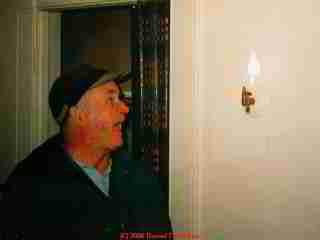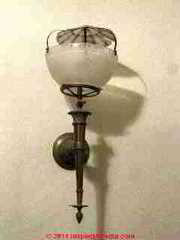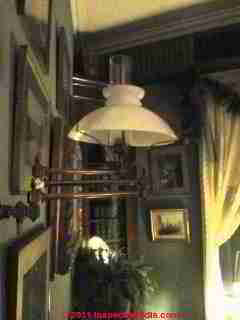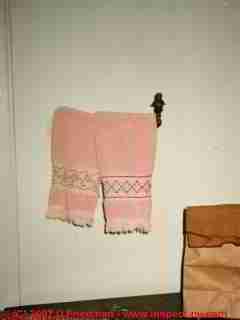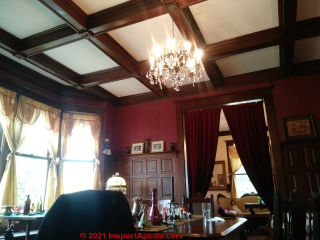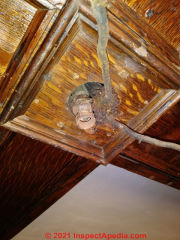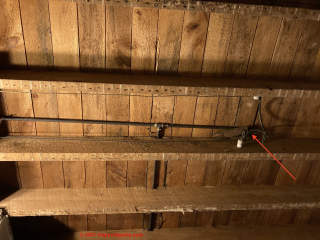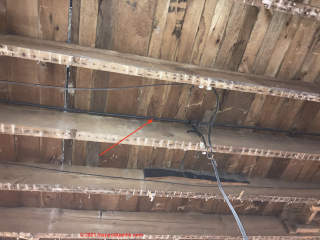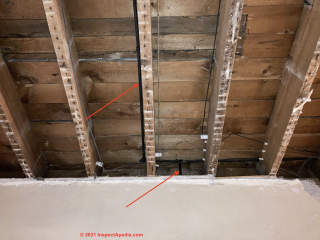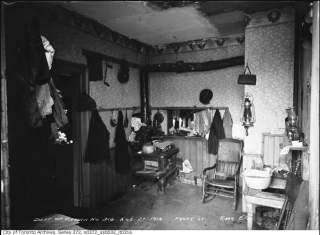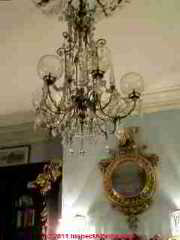 Check or Abandon Old Gas Lighting Pipes & Fixtures
Check or Abandon Old Gas Lighting Pipes & Fixtures
History, photos, explanation of antique gas lighting systems
- POST a QUESTION or COMMENT about gas piping in antique or other old buildings: gas piping, gas lighting & other gas fixtures in historic homes
Working or antique or abandoned gas piping & fixtures:
This article describes how to recognize & evaluate the safety of antique gas fixtures and piping that may be found in historic homes or other older buildings.
Here we provide descriptions and photographs of unsafe gas piping, indications of unsafe or improperly operating gas appliances, gas meters, and other gas installation defects are provided
This document series on inspecting gas piping in buildings also provides free sample draft home inspection report language for reporting defects in oil and gas piping at residential properties.
InspectAPedia tolerates no conflicts of interest. We have no relationship with advertisers, products, or services discussed at this website.
How to inspect, report, & correct antique or old gas lighting piping & fixtures
Gas piping in older buildings may have been cut-off from its source, re-used for electrical wiring, or, surprise, antique gas piping is sometimes found still connected and "live"!
When inspecting an older New York home we demonstrated that simply turning a small key on the wall fixture shown in the photo permitted lighting an antique gas light that was installed before 1900.
Watch out: improper installation and even improper inspection and testing methods involving natural or "LP" gas can involve dangerous conditions and risk fire or explosion.
If you smell gas you should leave the building immediately and should do so without doing anything that could create a spark such as operating a light switch or telephone.
From a safe location, call your gas company's emergency line and/or your fire department.
Use the page-bottom or top CONTACT link or post a comment at page bottom to suggest text changes and additions and, if you wish, to receive online listing and credit for that contribution.
NOTICE: while example report language is provided here, reproduction of this or any of our web pages or their contents at other websites or in printed documents for sale is prohibited.
Gas Fixtures & Piping in Historic & other Older Homes
Evaluating old gas lighting and other gas fixtures and fittings in older homes.
It may be possible to make safe use of gas lighting in homes, both indoors and out, provided that the piping and fixtures have been installed according to contemporary building codes and that the piping and fixtures are in good condition.
But here we address the discovery of antique gas lights and piping in homes.
Generally such fixtures and pipes should be considered a safety hazard, unless the system has been thoroughly inspected and brought to modern safety standards.
Our photo (above) and the next wall-mounted antique gas-light shown below illustrates an intact wall lighting sconce located in the Samuel Morse Home in Poughkeepsie, NY.
The photographs of various antique and even historic gas lights as well as remains of wall-mounted gas lights in other older buildings found in this article are a reminder that a building owner or her home inspector should never assume that old gas lines in a building are no longer connected to a gas source.
Watch Out: don't assume that all "old or antique gas pipes" in a building have been actually disconnected from the gas supply.
The photograph at the top of this page shows our discovery of an antique indoor gas lighting fixture which was being used as a towel rack. The building owner had always assumed the gas piping was inactive.
The photo above shows another type of wall mounted gas light, also in the Samuel Morse historic homestead in Poughkeepsie, NY.
While the gas piping routes in some older Victorian homes have often been converted to use for electrical wiring, often we've been surprised to find that supposedly long-abandoned gas fixtures, pipes, and fittings, are actually still active, and potentially dangerous.
These photographs show still-active gas-lighting piping in homes built around 1900, with the gas fittings still active nearly 100 years later!
A child pulling on the towel on that funny "towel rack" could have resulted in a catastrophe.
Gas to Electric Light Conversion in an 1880s Arkansas Home
These photos, provided courtesy of an InspectApedia.com reader illustrate the conversion of a ceiling-mounted gas-lit chandelier to electricity in an Arkansas home built in the 1880s. We don't have more-precise dates on the conversion.
Above the chandelier is almost certainly a modern light fixture; the original would probably have had fewer bulbs.
Below you can see the electrical wiring that was installed alongside the original gas piping protruding from the ceiling of this room.
In this instance the wires to the ceiling light were routed alongside the original gas piping.
Original Gas Lighting Piping in a Toronto Row House - 1888
2021/05/04 - why would they need 2 terminations of plumbing in each living and dining room ceilings?
We’ve demolished the seemingly original plaster and lath ceiling in our home (1888, row house, Toronto).
[Click to enlarge any image]
We have uncovered these metal pipes. They appear to come up from the basement in the wall and then service the living room and dining room, with terminations in the middles of the rooms and the edges. They don’t turn up to go upstairs.
It seems strange that they are defunct, since this space shouldn’t have been accessible if the ceiling was original.
Are they some pre-knob and tube electrical? Oil? (some kind of ancient sprinkler…?) Some kind of grounding system?
They don’t appear to be plumbing - why would they need 2 terminations of plumbing in each living and dining room ceilings.
Very curious! Let me know if you have any insight. - Anonymous by private email
Moderator reply
My guess is that those are black iron gas pipes from a gas-lighting system in your building, possibly dating from before the knob-and-tube electrical wiring was installed.
Those pipes about the right size, age, material, and location, and it's perhaps no coincidence that when the K&T wiring was later run for electric lights the installer chose about the same routing location for that wiring.
In some older buildings the electricians installing electric lights actually made use of the gas pipes as electrical conduit; Your piping is small in diameter and may have not been suitable for that conversion; it's also the case that in
some buildings both electric and gas lighting remained in use together for a time.
The reason for two terminations of this piping in each living room and dining room ceiling would have been to provide better lighting by feeding two gas light fixtures.
When your 1888 Toronto home was built, electric lighting in Toronto was just nine years old, while gas lighting using coal gas distributed by pipelines in the city saw use beginning in December 1841.
Although the City of Toronto began replacing those flickering gas lamps by electric street lights in 1880, progress was slow and in most homes as well as along streets, gas distribution for lighting remained in use in the 1880s. The first occupants of your home may have watched in the evening as gas lamp-lighters, employed by the Consumer's Gas Company, as they went methodically from one street lamp to another, igniting coal gas street lights.
Toronto Hydro didn't begin public-distribution of electricity intended for home use until May 2, 1911, so it's entirely reasonable that your home would have made use of gas lights and then later, both gas and electric lighting and perhaps candles or kerosene lanterns as well during its early life.
Widespread use of electric lighting in Canadian homes didn't really take off until after 1900, with a surge in use of electricity in Ontario beginning after completion of the electric power generators at Niagara Falls in 1906.
According to toronto.ca historical information,
Electric lighting was first witnessed in Toronto in 1879 at McConkey's Restaurant, located at 145 Yonge Street. To the delight of customers, the restaurant was lit up by two arc lamps powered by a small generator driven by a portable steam engine. Wright built the first Canadian-made electric generator in 1881. - "Turning On Toronto: Setting the Scene", toronto.ca/ retrieved 2021/05/11
Notice in this toronto.ca photograph (above) from the City of Toronto archives that in this home, rear 512 Front Street, photographed in August 1914, the occupants were still making use of kerosene oil lamps for lighting. We see at least two oil lamps at the right side of this photo.
History of Gas & Electric Lighting
Illustration: Grafton's 1820 discussion of a gas light system explosion.
- Andrews, William Ressman, ONE HUNDRED YEARS of GAS LIGHTING [PDF] Scientific American 123, no. 22 (1920): 544-544.
Excerpt:
The centenary of illumination by gas practically falls in this year. Eighteen hundred and twenty was the dividing line between the experimental stage of gas lighting and the period of its demonstrated practiability. The history of its expansion is similar to other discoveries in physical science which have developed factors now recognied as fundamental in the advancement of modern civilization. - Gill, Thomas. "On improvements in gas-lighting." Journal of the Franklin Institute 6, no. 1 (1828): 27-29.
- Grafton, John. "GAS LIGHTS." The Kaleidoscope: or, Literary and scientific mirror 2, no. 83 (1820): 132-132.
Reports on a gas explosion in early gas lighting. Excerpt:
Having been desired by the Committee of the Gas Works in this city to investigate the cause of the late unfortunate accident at Newcastle, from an explosion of gas in a private house, I am further directed to communicate the result of my inqiries to the public ...
The explanation is so satisfactory, and can be so easily understood, that i do not entertain a doubt of an immediate cessation of the alarm that the subject may have excited.
The accident at Newcastle occurred from a very great quantity of gas having escaped from the main or street pipe, which, making its way through the ground, accumulated under a boarded floor of the adjoining house (under which there was no cellar), and from under the floor into a cupboard, was there set fifre to by a candle, and exploded.
Now, it is plain that but for the ESCAPE of the gas from the pipe it could no thave accumlated in the house: my inquiry was, therefore, particularly directed to the cause of the failure of the pipe. I found that it escaped from a JOINT, where a fracture had taken place; and all surprise ceased when I was infored that it was what is called a FLANGE JOINT; which I have always reprobated, and never on any account use. - Greenwood, Regina & Charles D. Wrege THE MARKETING of GAS LIGHTING in AMERICA 1909 - 1916 [PDF] (2001, May). The Marketing of Gas Lighting in America: 1909-1916. In Proceedings of the Conference on Historical Analysis and Research in Marketing (Vol. 10, pp. 49-57).
- Hatchard, T. "DISCOVERY OF GAS-LIGHTING." The Mirror monthly magazine 11, no. 313 (1828): 340-341.
- KNOB & TUBE WIRING - history, photos, inspection, repairs
- Myers, Denys Peter. Gaslighting in America: A guide for historic preservation. No. 3. US Department of the Interior, Heritage Conservation and Recreation Service, Office of Archeology and Historic Preservation, Technical Preservation Services Division, 1978.
- North British Association of Gas Managers. Light Without a Wick: A Century of Gas-lighting, 1792-1892: a Sketch of William Murdoch, the Inventor. R. Maclehose, 1892.
- Peckston, Thomas Snowdon. "The theory and practice of gas-lighting." The Monthly Magazine 47, no. 328 (1819): 598-614.
- Ross, Alex, and Bernarda Gospic, "A Brief History of Toronto Street Lamps", The Varsity (the University of Toronto’s Student Newspaper Since 1880) , October 28, 2012, retrieved 2021/05/11 original source: https://thevarsity.ca/2012/10/28/a-brief-history-of-toronto-street-lamps/
Excerpt: Victorian Gas Lights, which can be found in front of St. Lawrence Hall, are all that’s left of the old gas lighting system that was first installed in 1841 by the Toronto Gas, Light, and Water Company. Before the perfection of electric lighting, gas lights were the primary lighting solution for most mid-nineteenth century cities.
The use of coal gas to light these lamps meant they were often dirty, unreliable (they could easily flicker out if not constantly lit), and smelled awful. Widespread dissatisfaction led to the replacement of gaslights with electric lights in Toronto starting in 1880. - Tomory, Leslie. Progressive enlightenment: the origins of the gaslight industry, 1780-1820. MIT Press, 2012.
- Toronto.ca: the City of Toronto provides a wonderful series of historic articles and photographs on the electrification of the city, under the aegis of "Turning on Toronto: a History of Toronto Hydro", beginning at "Turning on Toronto: Setting the Scene" found at this rather unwieldy link
https://www.toronto.ca/explore-enjoy/history-art-culture/online-exhibits/web-exhibits/web-exhibits-local-government/turning-on-toronto-a-history-of-toronto-hydro/turning-on-toronto-setting-the-scene/#:~:text=Electric%20lighting%20was%20first%20witnessed,by%20a%20portable%20steam%20engine.&text=Wright%20built%20the%20first%20Canadian%2Dmade%20electric%20generator%20in%201881. - Wikipedia: Toronto Electric Light Company -https://en.wikipedia.org/wiki/Toronto_Electric_Light_Company excepted below retrieved 2021/05/11
The Toronto Electric Light Company was an early electricity supplier in Toronto, founded and presided over by John Joseph Wright (1847–1922) and owned by Sir Henry Pellatt.
Founded in 1882, TELC opened a steam driven power plant at Scott Street and The Esplanade. The plant was used to win a contract to provide night time street lighting (50 lights), replacing the oil and kerosene lamps in the old city of Toronto on King, Queen and Yonge Streets.
By 1884 it was "used by a number of prominent establishments" as well.
This power plant lasted into the 1920s when it was replaced by Central Heating Plant.
TELC was eventually linked to Toronto Power Company and in 1906 TELC Toronto Power Generating Station was opened at Niagara Falls, Ontario to harness hydro electric power for Toronto.
The company was acquired by the Hydro-Electric Power Commission of Ontario in 1922, after private utilities ended in the early 1900s under the order of Sir Adam Beck. - Also seeReferences or Citations at the end of this page
Old or Abandoned Gas Piping & Fixtures: safety warnings
Immediate LP or natural gas safety hazards: if there is evidence of an LP or natural gas leak at a building, gas odors, for example, you should:
- Do not do anything that is likely to cause a gas explosion, such as lighting a match, operating an electrical switch, or even using a telephone in the building
- Leave the building immediately and keep a safe distance away - 100 feet or more.
- Notify other building occupants of the safety concern
- Contact the local gas company and/or fire department
Heating equipment which the inspector (or building occupant or manager) judges to be an immediate life safety hazard should be shut down and appropriate emergency services called.
See GAS LEAK DETECTION, LP / NG for leak detection procedures and alternatives.
Other LP & Natural Gas Home Safety recommendations
- Gas piping support: check that gas lines are adequately supported - this will help avoid leaks.
- Abandoned gas piping in buildings: we recommend that unused gas equipment be removed and that you have the unused section of gas line properly sealed by a qualified plumber or by your gas supplier. Leaky old appliances or gas lines are dangerous.
Reader Comments, Questions & Answers About The Article Above
Below you will find questions and answers previously posted on this page at its page bottom reader comment box.
Reader Q&A - also see RECOMMENDED ARTICLES & FAQs
On 2022-12-28 22:51:13.976810 by InspectApedia Publisher (mod)
@Gina S,
History of antique gas lights and how they were ignited.
For high gas lights such as on lamp posts or hanging fixtures, an igniter was lifted on a long pole. Gas street lights in London were common beginning in the first decade of the 19th century - ca 1810, and were lit by the famous "gaslighter" who used an eight-foot pole.
Atop the pole was simply a small torch.
Some high wall-mounted gas fixtures were also lit by climbing a ladder but you'll understand that that would have been a bit unwieldy for street lighting.
It would be kind of you to share some history, a description of your product, and what else you have found about the history of gas lights in Europe, the U.K., North America, etc.
On 2022-12-28 20:02:17.610677 by Gina S
@InspectApedia Publisher,
Thank you so much! And what would they do to light a gasolier, or a fixture hanging high in a ceiling?
On 2022-12-28 19:40:10.210009 by InspectApedia Publisher (mod)
@Trevor,
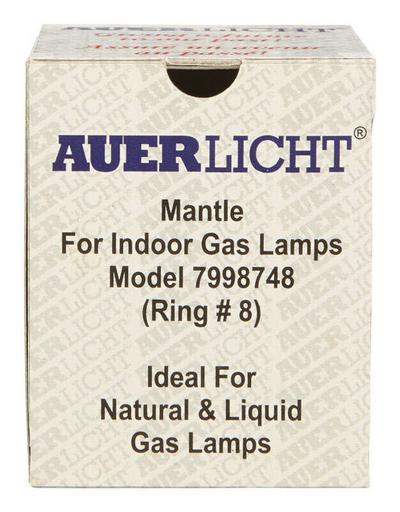
On 2022-12-28 19:38:09.602251 by InspectApedia Publisher (mod)
@Trevor,
That's very interesting, thank you for the additional photo.
So if that gas light is still live and working, would I be correct that that white material around it is some type of light shade?
If so do we know it's age?
In your second photo I THINK I see a gas lantern mantle that actually provides air to the gas supply to support the gas light flame. This type of gas light - if that's what we're seeing, produces much more light output than would a simple bare gas flame like that shown in some of the other antique gaslight fixtures on this page.
Seems to me that both the gas mantle and the light shade itself must be made of asbestos or another non-combustible material.
Gas Mantles are still sold for use in gas lamps, such as this example from Auerbach.

On 2022-12-28 19:30:41.078968 by InspectApedia Publisher (mod)
@Gina S,
and of course, the gas supply into the building must also be turned on.
Other photos of gas light fixtures and controls are on this page.
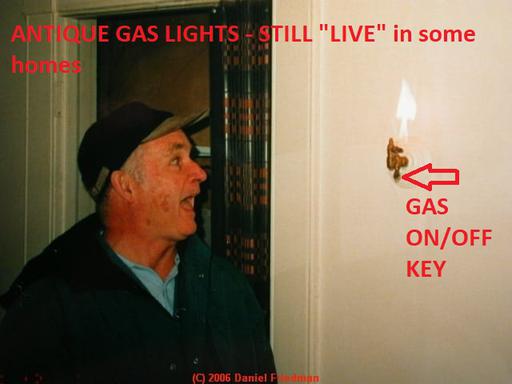
On 2022-12-28 19:29:53.567618 by InspectApedia Publisher (mod)
@Gina S,
In two photos we'll show here you'll see that each gas light fixture includes a key that is turned to open or close the gas supply.
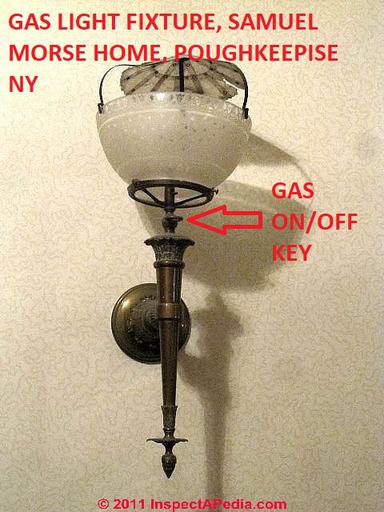
On 2022-12-28 18:53:33.523049 by Gina S
hi - Research question here, but what was the most common way to turn on a gasolier that was hanging high in a hall, around 1910? Was there a button or key on a wall that would've done that?
On 2022-09-29 05:07:16.732233 by Trevor
Will add another photo , is a wall mounted gas light in Hervey bay Qld Australia , around 30 years old
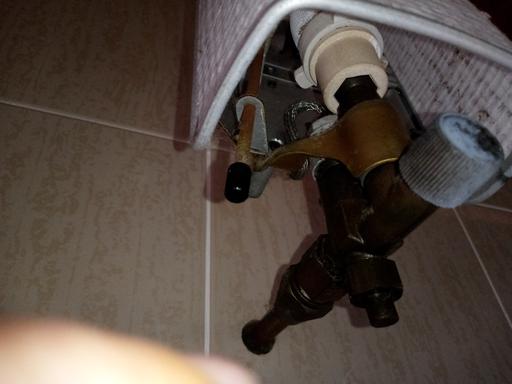
On 2022-09-28 12:20:44.379118 by InspectApedia (Editor) (mod)
@Trevor Savill,
Sorry, I can't say anything useful without at least some contextual information about your image.
All I can see is what looks like a rectangular fabric-like cover over something unknown, with a metal base that might be on a wall or floor, and a stub of what might be a bit of pipe or something else sticking out of what looks like a ceramic tile covered surface.
It's as if you said "there's something in my house, what is it, what do I do with it, how does it work?"
Tell me, for example,
What are we looking at:
is this a shade or cover over an electric light bulb
mounted on a wall?
mounted at an old gas pipe?
Is there gas service in the building?
Is there an electric light bulb inside that fixture?
Is there a gas jet inside that fixture?
Is this in a home or commercial building?
What are the country and city of location?
What is the building age?
On 2022-09-27 22:55:48.901252 by Trevor Savill
Would like to identify this product please , and possibly service instructions

On 2022-03-29 22:50:40.132333 by Inspectapedia Com Moderator (mod)
@Tamara,
That could be an old gas valve.
On 2022-03-29 20:48:17.884690 by Tamara
I have this in my bathroom right above my floor on the baseboard anyone know what this is
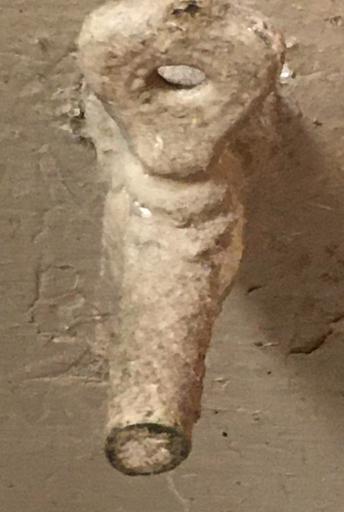
On 2021-09-06 00:30:59.586031 by inspectapedia.com.moderator (mod)
@ownsmoneypit,
A ceiling fan requires a special, strong ceiling mounting box that is secured to building framing.
To connect a fan hanger box to an unused, abandoned pipe in a ceiling, you'd want to know exactly the routing of the pipe and how it is in turn secured to building framing.
On 2021-09-05 23:59:49.297124 by ownsmoneypit
I have an old house that has old gas line pipes in ceiling for fixtures, is there any way that I can attach a ceiling fan to the pipe instead of putting in a fan brace?
...
Continue reading at GAS LEAK DETECTION, LP / NG or select a topic from the closely-related articles below, or see the complete ARTICLE INDEX.
Or see GAS LIGHTING PIPES FIXTURES FAQs - questions & answers about gas lights and gas light piping posted originally at this page.
Or see these
Gas Piping Articles
- GAS LIGHTING PIPES FIXTURES
- GAS LP & NATURAL GAS SAFETY HAZARDS
- GAS PIPING, VALVES, CONTROLS - home
- FLARE FITTINGS
- FLEXIBLE GAS CONNECTOR INSTALL
- GAS PIPING CLOG REPAIR
- GAS PIPING CLEARANCES, CODES & DEFECTS
- GAS PIPING, FLEXIBLE CSST
- GAS PIPING SIZE & MATERIAL
- GAS LEAK DETECTION, LP / NG
- GAS PRESSURES LP vs NATURAL GAS
Suggested citation for this web page
GAS LIGHTING PIPES FIXTURES at InspectApedia.com - online encyclopedia of building & environmental inspection, testing, diagnosis, repair, & problem prevention advice.
Or see this
INDEX to RELATED ARTICLES: ARTICLE INDEX to PLUMBING SYSTEMS
Or use the SEARCH BOX found below to Ask a Question or Search InspectApedia
Ask a Question or Search InspectApedia
Questions & answers or comments about gas piping in antique or other old buildings: gas piping, gas lighting & other gas fixtures in historic homes.
Try the search box just below, or if you prefer, post a question or comment in the Comments box below and we will respond promptly.
Search the InspectApedia website
Note: appearance of your Comment below may be delayed: if your comment contains an image, photograph, web link, or text that looks to the software as if it might be a web link, your posting will appear after it has been approved by a moderator. Apologies for the delay.
Only one image can be added per comment but you can post as many comments, and therefore images, as you like.
You will not receive a notification when a response to your question has been posted.
Please bookmark this page to make it easy for you to check back for our response.
Our Comment Box is provided by Countable Web Productions countable.ca
Citations & References
In addition to any citations in the article above, a full list is available on request.
- U.S. Energy Information Administration - eia.doe.gov/
- U.S. Environmental Protection Agency - epa.gov/solar/energy-and-you/affect/natural-gas.html
- At Natural Gas.Org www.naturalgas.org/environment/naturalgas.asp#emission you’ll find a table of combustion products
- At geocities.com/rainforest/6847/report1.html is an interesting and detailed though not “neutral” report on the components and contaminants in the combustion of natural gas. You’ll see a long long list of emissions products, but look again – most of the contaminant levels listed are in the picograms.
- apvgn.pt/documentacao/iangv_rep_part1.pdf lists the components in natural gas exhaust from vehicles
- The Need Project, Manassas, VA: need.org/needpdf/infobook_activities/SecInfo/NGasS.pdf
- Kroschwitz, Jacqueline I., and Mary Howe-Grant (eds.). "Gas, Natural." In Encyclopedia of Chemical Technology. 4th ed., vol. 12. New York: John Wiley and Sons, Inc., 1993.
- Tussing, Arlon R., & Bob Tippee. The Natural Gas Industry: Evolution, Structure, and Economics. 2nd ed. Tulsa, OK: PennWell Publishing, 1995.
- Our recommended books about building & mechanical systems design, inspection, problem diagnosis, and repair, and about indoor environment and IAQ testing, diagnosis, and cleanup are at the InspectAPedia Bookstore. Also see our Book Reviews - InspectAPedia.
- Carbon Monoxide Gas Toxicity, exposure limits, poisoning symptoms, and inspecting buildings for CO hazards
- In addition to citations & references found in this article, see the research citations given at the end of the related articles found at our suggested
CONTINUE READING or RECOMMENDED ARTICLES.
- Carson, Dunlop & Associates Ltd., 120 Carlton Street Suite 407, Toronto ON M5A 4K2. Tel: (416) 964-9415 1-800-268-7070 Email: info@carsondunlop.com. Alan Carson is a past president of ASHI, the American Society of Home Inspectors.
Thanks to Alan Carson and Bob Dunlop, for permission for InspectAPedia to use text excerpts from The HOME REFERENCE BOOK - the Encyclopedia of Homes and to use illustrations from The ILLUSTRATED HOME .
Carson Dunlop Associates provides extensive home inspection education and report writing material. In gratitude we provide links to tsome Carson Dunlop Associates products and services.


